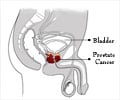Prostate cancer is the most common cancer diagnosed in men and the risk of developing this cancer increases with age. The optimal or the best form of therapy for prostate cancer remains still a debate.
Currently, three surgical options are available to patients: traditional open surgery, laparoscopic (also known as minimally invasive) surgery and robotic-assisted laparoscopic surgery.Prostate cancer patients biggest concerns following these treatment options are the possible side effects of surgery, including urinary incontinence and sexual impotency. In an attempt to find which of the options is better, a detailed study has been conducted concentrating on the associated factors.
Among the various parameters analyzed, robotic surgery and minimally invasive surgery were found to be associated with reduction in blood loss and post surgical complications in addition to shorter hospital stays. However, there is no evidence that the procedure improves cure rates. Infact the cure rates for all three procedures were found to be identical.
Open prostatectomy had a significantly higher overall complication rate of 15 percent, while non-robotic laparoscopic prostatectomy had a rate of 10 percent and robotic-assisted had a complication rate of 5 percent. Cost was the one area in which the older open surgery was the clear winner.
Robotic surgery requires a high level of skill and expertise to handle complex instrumentation. Robotics allows surgeons to work seated at a console a few feet away from the operating table, pushing a joystick and pressing foot controls to remotely manipulate the three robotic arms at the bedside. Robotics is meant to eliminate hand tremors, but some surgeons find the lack of contact with instruments disconcerting.
So far, patient demand, not evidence, is the driving force behind the rise in robotic-assisted prostatectomy, with many willing to travel for the robotic procedure. However, patients have to rely more on surgeon experience and efficiency rather than just picking the latest technology. Hospitals have to consider whether they can use the system for more than one type of procedure to make it worth the capital equipment investment, if the institute can use it for many applications.
Advertisement

![Prostate Specific Antigen [PSA] Prostate Specific Antigen [PSA]](https://www.medindia.net/images/common/patientinfo/120_100/prostate-specific-antigen.jpg)






